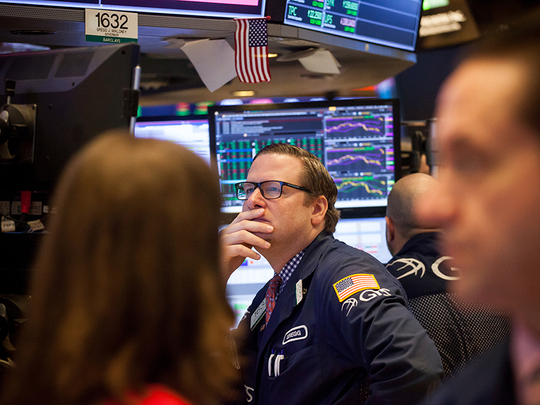
New York: After suffering unprecedented losses last year, currency-focused hedge funds were hoping a bit of market turbulence would help them get back on track in 2018. Things could hardly have gone worse.
A BarclayHedge gauge of foreign-exchange trading programs slumped 2.5 per cent over the first three months of 2018, extending last year’s record 11 per cent plunge. Even FX stalwarts — from Warren Naphtal’s P/E Investments to Bill Lipschutz’s Hathersage Capital Management — haven’t been immune, sliding along with peers after years of dominant returns.
For money managers who’ve long bemoaned how central-bank policies have crimped volatility, the first quarter proved unusually cruel. Currency swings broadly remained subdued, especially when compared to stocks and bonds. And what market gyrations were seen were often the product of unexpected political developments or, more recently, unforeseeable tweets from the White House. It points to another frustrating year for investors who need volatile markets to make money, but can’t capitalise on moves they don’t see coming.
“What is the real driver of volatility — if it is political headlines and tweets from Trump, you’re not going to make any money because political noise is about surprise,” said Bob Savage, chief executive officer of Track Research, a website for investment analysis. “You can’t anticipate it — you don’t know how much cash to have ahead of a tweet.”
A JPMorgan Chase & Co gauge of three-month implied option volatility in global foreign-exchange rates has averaged just 7.87 per cent this year, compared to 8.44 per cent last year and 10.61 per cent in 2016. Even amid the tumult kicked up by US. President Donald Trump’s criticism of Amazon.com and escalating trade tensions with China, currencies have broadly remained calm.
“I don’t think that anybody can position ahead of a Trump tweet, but that’s what you’re in the business to be able to manage,” said Steven Englander, head of research and strategy at global macro fund Rafiki Capital Management.
It stands in stark contrast to recent turbulence in equities and Treasuries. The Cboe Volatility Index, a gauge of price fluctuations in US stocks, skyrocketed in February before spiking anew over the past couple weeks. Bank of America Corp’s MOVE Index, a measure of bond-market volatility, breached 70 last quarter for the first time in almost a year.
What moves there have been in FX have often caught speculators off guard. Leveraged accounts entered 2018 near the most bearish on the yen since 2007, according to Commodity Futures Trading Commission data. The currency’s surge amid escalating global trade tension and a domestic political scandal that threatens to curtail Japan’s economic-stimulus program has forced investors to abandon their bets and wiped out returns on carry trades in the process.
Problem with tariffs
The looming spectre of a global trade war casts a long shadow on the global growth outlook and can confound currency-focused hedge funds and commodity-trading advisers, according to Jason Schenker, president and chief economist at Prestige Economics.
“The problem with tariffs is they’re like cockroaches — there’s never just one,” said Schenker, whose firm was the third-best currency forecaster in the first quarter, according to Bloomberg rankings. “There’s another wrinkle of complexity in the foreign-exchange market that we haven’t seen as a major concern in decades.”
Despite a slew of recent upbeat headlines, traders are underestimating the risk of a breakdown in North American Free Trade Agreement negotiations, he said.
Hathersage, whose founder Bill Lipschutz is known as the “Sultan of Currencies,” saw its G10 Macro Access Strategy fall 6.1 per cent in the first quarter, adding to a 23 per cent loss last year, figures compiled by Citigroup Inc show. The strategy gained 38 per cent in 2016.
P/E Investments’ FX Strategy slid 5.1 per cent in the first three months of the year after a 27 per cent decline in 2017. That’s a turnaround for the multibillion-dollar fund cofounded by Warren Naphtal, which posted annual returns between 20 and 50 per cent from 2014 to 2016, the Citigroup data show.
Hathersage and P/E Investments declined to comment.
Best bets
Some of the most popular currency trading strategies fell flat in the first quarter, crimping returns, according to Van Luu, head of currency and fixed-income strategy at Russell Investments in London. Momentum trades have been “terrible” and trend-following bets also underperformed, he said.
“One strategy that has worked well in the FX space this year and I think will continue to work well is value,” said Luu. Valuation trading involves buying underpriced currencies and selling expensive ones based on measures of purchasing power. These bets could include buying the yen, euro, pound and Canadian dollar and selling the Swiss franc or Norwegian krone, he said.
Tactical trading
Still, currency traders shouldn’t expect the current low volatility regime to play out indefinitely, according to Sinead Colton, head of investment strategy at BNY Mellon Asset Management North America.
Further protectionist barriers, central-bank tapering or a spike in inflation could shake currencies out of their torpor, she said.
Yet after a lousy first quarter, investors have already begun to adjust to the new environment, according to Rafiki’s Englander.
“There’s a big shift in hedge fund strategies,” Englander said. Investors are moving away from what he calls real-money trades, or traditional bets on economic fundamentals, into “much more tactical trading, trying to take advantage of the volatility that has been introduced.”





